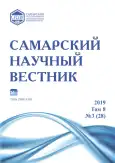Биоценотические комплексы озёр и эстуариев южного и центрального Приморья
- Авторы: Милованкин П.Г.1
-
Учреждения:
- Тихоокеанский филиал Всероссийского научно-исследовательского института рыбного хозяйства и океанографии
- Выпуск: Том 8, № 3 (2019)
- Страницы: 52-59
- Раздел: Общая биология
- URL: https://journals.rcsi.science/2309-4370/article/view/34352
- DOI: https://doi.org/10.17816/snv201983108
- ID: 34352
Цитировать
Полный текст
Аннотация
Проведённые в 2005–2013 гг. в тёплый период года (май – октябрь) исследования озёр и эстуариев центрального и южного Приморья позволили выделить различия между ними по составу уловов рыб и нектобентоса (крабов, креветок и шримсов). В соответствии с данными кластерного анализа, в исследованных водоёмах выделены 7 биоценотических комплексов: озёра юга Приморье и придаточная система р. Раздольной; реки Гладкая и Тесная; реки Рязановка, Барабашевка, устье реки Артёмовка и реки центрального Приморья; нижнее течение р. Раздольной, реки Артёмовка и Шкотовка, верхняя часть эстуария Суходола; основная часть эстуария Раздольной; эстуарий Суходола и мористая часть эстуариев центрального Приморья. Средняя удельная биомасса гидробионтов в озёрах и эстуариях южного и центрального Приморья составляла 6,4 г/м², или (что то же самое) т/км², из них рыб – 84,7% по массе. По биомассе преобладали: пиленгас Planiliza haematocheila (1,036), на втором месте молодь краснопёрки Tribolodon spp. (0,904) и на третьем месте – японский мохнаторукий краб Eriocheir japonica (0,606 г/м²). Во всех семи биоценотических комплексах отмечены Acanthogobius lactipes, шримсы Crangon spp., Gasterosteus nipponicus, Gymnogobius urotaenia, Palaemon spp., Pungitius sinensis, Tribolodon spp. и Tridentiger brevispinis. Всего выполнено 68 микросъёмок (700 ловов) в тёплый период года (май – октябрь), выявлено 106 таксонов рыб и нектобентоса.
Ключевые слова
Полный текст
Открыть статью на сайте журналаОб авторах
Павел Геннадьевич Милованкин
Тихоокеанский филиал Всероссийского научно-исследовательского института рыбного хозяйства и океанографии
Автор, ответственный за переписку.
Email: academkin@mail.ru
научный сотрудник лаборатории прикладной биоценологии
Россия, ВладивостокСписок литературы
- Колпаков Н.В. Структурно-функциональная организация эстуарных экосистем северо-западной части Японского моря.: дис. … д-ра биол. наук: 03.02.08. Владивосток, 2017. 523 с.
- Волова Г.Н. Основные биоценозы континентальных водоёмов Южного Приморья // Учёные записки ДВГУ. 1971. Т. 15, № 3. С. 85–97.
- Волова Г.Н. Классификация водоёмов морского побережья Южного Приморья по составу фауны // Учёные записки ДВГУ. 1972. Т. 60, № 6. С. 117–133.
- Барабанщиков Е.И. Зоопланктон и типизация внутренних эстуариев рек южного Приморья // Биомониторинг и рациональное использование гидробионтов: тез. докл. конф. молодых учёных. Владивосток: ТИНРО-центр, 1997. С. 87–88.
- Барабанщиков Е.И., Магомедов Р.А. Состав и некоторые черты биологии рыб эстуарной зоны рек южного Приморья // Известия ТИНРО. 2002. Т. 131. С. 179–200.
- Колпаков Н.В. Новые данные по составу и распределению рыб в эстуариях южного Приморья. 2. Малые водоемы // Известия ТИНРО. 2008. Т. 153. С. 167–180.
- Трещев А.И. Интенсивность рыболовства. М.: Легкая и пищевая промышленность, 1983. 236 с.
- Старобогатов Я.И., Хлебович В.В. Проблема типологии солоноватых вод // Гидробиологический журнал. 1978. Т. 14, № 6. С. 3–6.
- Лебедева Н.В., Криволуцкий Д.А., Пузаченко Ю.Г. и др. География и мониторинг биоразнообразия / ред. кол. Н.С. Касимов, Э.П. Романова, А.А. Тишков. М.: Издательство Научного и учебно-методического центра Моск. ун-та, 2002. 432 с.
- R Core Team. R: A language and environment for statistical computing. Vienna: R Foundation for Statistical Computing, 2018.
- WoRMS Editorial Board. World Register of Marine Species [El. resource] // http://marinespecies.org at VLIZ. 2019. doi: 10.14284/170.
- Simpson E.H. Measurement of diversity // Nature. 1949. Vol. 163, № 4148. P. 668.
- Шитиков В.К., Розенберг Г.С., Зинченко Т.Д. Количественная гидроэкология: методы системной идентификации. Тольятти: ИЭВБ РАН, 2003. 463 с.
Дополнительные файлы








